Blogs
A GORGEOUS DAY WITH TWO MORE 40+ KNOT RUNS POSTED...BUT...!!!

Yesterday was one of the best days I have seen over at the Walvis Bay 'Speed-spot'.
The water was a beautiful blue as was the sky and the wind was pumping in at around 20 knots with higher gusts. We weaved VESTAS SAILROCKET through the ever increasing fleet of Hobie cats present on the lawn of the Walvis Bay Yacht Club and made our way across the lagoon. As ever I was keen to make a big run and continue our climb up the numbers. Rough rides in bumpy water with the large rudder down are no longer acceptable. The last two runs were both done with the large low speed rudder up and it felt great. Today I would test the effectiveness of the hand steering/skeg flap at speeds over 40 knots. New guy Klaus would be our fifth man.
The first run went well. I sailed in nice and tight and had a relatively smooth ride. This had the double benefit of keeping the spray down. I used the hand steering for the whole 500 meter course and it seemed quite effective. The low speed rudder failed to kick up due to... and I'll be honest... user error on my part. In the long list of checks I do in between dropping the tether at the start and actually turning VESTAS SAILROCKET onto the course and accelerating, I hadn't released the rudder pull-down line and this held the rudder down after I released the 'up' trigger. By the time I realised we were already approaching 40 knots. A mistake on my part but it didn't involve any risk.
So we hit a peak speed of 42.3 knots. The wing was sheeted to only 20 degrees throughout this run. The reason for this was that I sheet in initially when both my hands are free as it is harder once one hand is being used for steering. For these first high speed runs using the hand steering I am concentrating very hard on this aspect and not so hard on the wing angle. It will all come with practice and familiarity. The wing flap sheeted on nicely and it all felt fine. Although VESTAS SAILROCKET responded well to the hand steering... it still didn't feel entirely precise. I was still weaving around a little.
RUN 45, MEAN WIND SPEED 18.5 KNOTS, TOP SPEED 42.5. WING ANGLE AT 20 DEGREES, WING FLAP ON, LARGE RUDDER STILL DOWN. USING HAND STEERING. POD VERY 'FLOATY'... AS IS FRONT END!
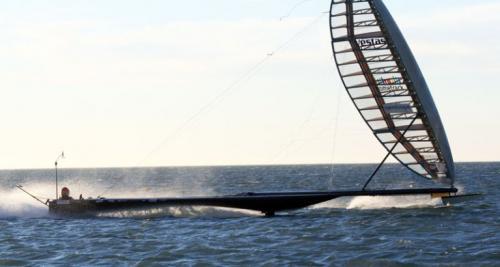
At the end of the run I was keen to get back up the course and try it again. The wind had built a little and I wanted a new top speed but more importantly... I wanted to nail a 42.5 knot average over the course. This is a performance milestone that we have set ourselves which we are now slightly overdue to achieve. I know we are more than capable and want to get it in our wake ASAP.
In my mind I was going to focus on sailing in tight, making sure the large rudder is kicked up and making sure that the wing was sheeted in harder before going to hand steering. Vestas SailRocket strained at the tether line as she swung her nose away from the beach in a long arc prior to release. She quickly powered over the 'hump' and up onto her planing surfaces whilst I began to bear away and line up the start of the course. This is always a sensitive part of the run as it is usually the phase where, if we are not careful a rounding up force can overpower the steering and send me into the beach. This time we were OK and I felt the reassuring force of leeward helm which signalled that all was well and VESTAS SAILROCKET was sailing as she was designed to do.
HEADING UP TO THE COURSE THROUGH THE START UP SEQUENCE FOR RUN 46.
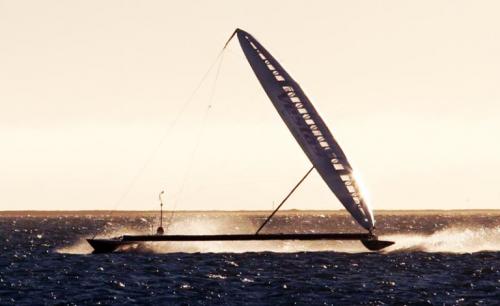
I sheeted the wing into 15 degrees and went to the hand steering. We were quickly up to 40 knots but I noticed I was using the full range of the skeg steering to hold the boat up onto the course. The aerodynamics were overpowering the hydrodynamics and the only way I could hold VESTAS SAILROCKET up onto the course was to put in a little bit of foot steering via the still deployed large rudder. This initiated a sharp turn to windward which is a little unsettling as it can instigate a high speed round-up. I was still at full forward lock on the hand steering so it was obvious that I couldn't kick up the big rudder. Visibility was good enough for me to be able to see the course. I held on for the full 500 meters and then brought the show to a stop.
The top speed was only slightly higher than the previous run but the run involved a lot more weaving. I wasn't happy. We should have done at least 45 knots in these conditions... and I mean at least. It was a perfect day.
So what happened? My first guess is that by sheeting in harder in slightly stronger winds on the second run, we simply had too much lee-helm i.e. the balance of the boat was making her want to turn away from the beach too hard. This can be quite quickly and easily compensated for in a number of ways. VESTAS SAILROCKET is a highly adjustable boat. We can either move the wing aft by swinging the beam or wing aft. This is done by simply adjusting the lashing lengths on the end of the fore and aft supporting cables. Another means of trim adjustment is to adjust the angle of the rear skeg to the main foil. This is done by a screw adjustment and is also quite simple. In all fairness, we can't expect our first stab at a high speed configuration to be exactly right and it will probably be something that we will be playing with until the end.
What does impress me about our current status is how smooth the whole operation is becoming. The overall, comfort, stress and functionality levels are all very good. We have the ability to just plug in a new team member and go and punch out consecutive 40 knot runs with little or no fuss. Although we still have many obstacles to overcome I really feel that we have emerged from our darkest days and that we are in great fighting shape. Our last big crash was on Run 23 and we have now doubled that amount of runs without incident.
I tried to go back for another run but as we got to the top of the course... the sun had made it to the horizon. We reluctantly packed up. I felt frustrated that we hadn't topped 44 knots at least but the fact is that we are always learning and in some cases it doesn't really matter if there is a tick or a cross in a certain box... as long as it answers a question that will show you the next direction you need to take.
CONCLUSION: Right now, at high speed in winds over 20 knots, the current boat configuration appears to be imbalanced to the point where the skeg steering cannot correct it. We need to reconfigure the boat. One good aspect is that VESTAS SAILROCKET is trying to turn away from the beach and hence danger in this setup. The visibility was improved in the cockpit by sailing in closer to the beach and hence in flatter water.
The data from the PI RESEARCH, B and G and TACKTICK loggers has all been downloaded and sent off to Malcolm. Both the onboard footage with pilot audio and the onshore footage with audio has been downloaded and co-ordinated with the PI RESEARCH data so that we can watch all the data and footage together on the computer in real time. It is a brilliant system that allows you to go back and really study the reality of a certain moment in time in intricate detail.
The weather does not look that favourable today as it is forecast to be quite light. In fact the rest of the week looks pretty average which means we will lose the remainder of this afternoon high tide. Things might change so we will stay on standby nonetheless. One of the main contenders for 50 knots, Hydroptere, is now back in the water and ready for sailing. She looks fantastic and I am eager to see what her new configuration will yield. Of course we want to beat her on the water and are doing all we can to do so. I am honestly glad that they are back and as hungry as ever to go faster. The competition is a healthy one.
Cheers, Paul
Runs 43-44. the wind comes, the wind goes... so do the spray deflectors!!!
We arose early this morning as the miraculous Mr 'M's time was up with us and we had to post him off to the airport. I finally got a great little boat builder down here at the Walvis bay 'coal-face'... and didn't break the boat once! Typical.
Helena and I returned to the slightly emptier container and pushed on with the joblist. Within an hour I was back in the mixing pots doing odd little jobs. We put the newly skinned wing back on Sailrocket and wheeled her into the hangar away from the UV rays. I gave the wing a thorough inspection and she seemed in pretty good shape considering the hard life we have given her to date.
Today marked three more months for us in Namibia on this latest trip. We were due to fly back but chose to stick around until we get some definitive results. We have now done 21 runs with no mishaps. Today was shaping up to be a great day. The newly logo'd Musto tops came back from Gino and the folks at DREAMWORLD in Walvis Bay... and we wear them with pride. The day looked great and we ran around all over the place looking for a good hand to replace Mr 'M' for the days sailing. In the end we were all standing around in drysuits... but couldn't go anywhere as we were too short staffed. As a last ditch effort I called a mate Gary who runs the best bar in town and he put me onto 'Sammy'... short for Samson. It was Samson's day off from running the bar and a couple of weeks earlier we drove a 2000 km round trip to go to Samson's traditional wedding way up in the North near Angola. We had his awesome smiling 'dial' in a drysuit in ten minutes... and we were off to 'speed-spot' once more.
The day just seemed to get better and better. I wanted to set a new best speed and a good 40+ average so that I could call Mr 'M' whilst he waited in the airport for his flight back to the UK. With this in mind I swung VESTAS SAILROCKET out onto the course for the 43rd time. As I rounded up onto the course I noted that she had adopted a rather nose down attitude and was stubbornly refusing to 'pop' up onto the plane. I tried all the tricks but she just mushed along. The spray deflector which hadn't hindered us on lighter days was now acting like a drogue. I had no option but to abandon the run somewhat disheartened. Our spray issues have not been resolved. Fortunately we had only stuck it on with Sika-Flex and I could cut it off with a piece of fine line.
VISIBLY NOSE DOWN ON RUN 43
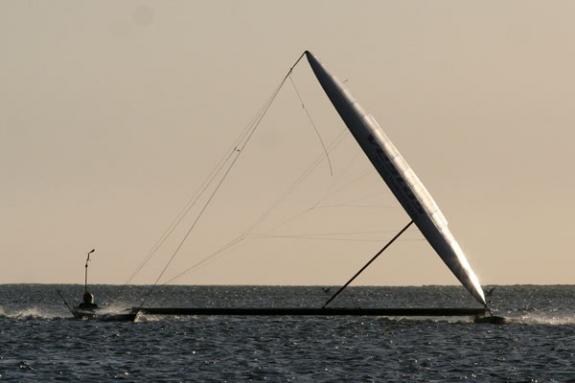
We took VESTAS SAILROCKET back up to the top of the course but as luck would have it... the wind was dying out. And die out it did. So run 44 went by in a low riding mode... so low in fact that I sailed the good ship all the way across the lagoon to the Yacht Club and parked it on the beach out front.
COMING INTO THE WALVIS BAY YACHT CLUB... PURE AFRICA
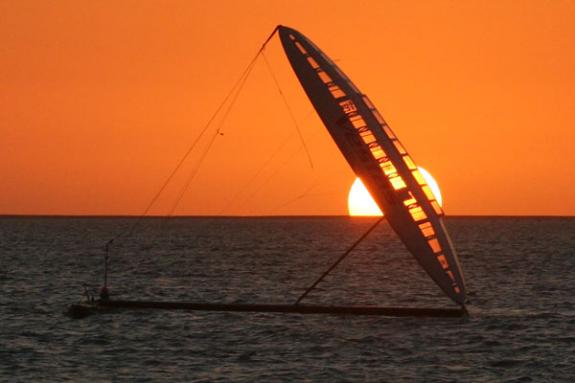
Ho-Hum. No joy there. We were a little late onto the water due to being a man down. We should be back up to strength as of Saturday when we will gain another local team member.
Overall the boat and team gets stronger by the day as the detail work gets attended to daily. The spray deflector did work... but it wasn't perfect. We still have it with us... but I will try some side skirts on the forward planing surface next... and a new forward planing surface after that. Let's see what tomorrow brings.
Cheers, Paul
Run 40 flies by, high and dry...
Although it was far from being the fastest... I would have to say that Run 40 was the cleanest run we have ever done on a number of fronts.
It was an extremely grey day which started with very little wind. One of the best 'care' packages you can ever receive in a sailing project arrived in Walvis Bay today in the form of two big boxes of MUSTO clothing! Inside, amongst many other things, were 5 new drysuits and they couldn't have arrived on a bleaker or more suitable day. We were busying ourselves with sorting through this, cutting down neck seals and so on and had all but given up on sailing as 3pm came and went.
The smell of sulphur was strong in the air. I mean real strong. In fact it stank of sulphur... like walking up a volcano. You get this from time to time as algae dies in the lagoon and decomposes on the bottom. The water goes milky and the smell of 'rotten eggs' fills the air. It's usually not quite this offensive.
I walked out of the container and saw that the wind was building. The walls of the container had begun to close in as we hadn't been sailing for a week or so. I leapt at the opportunity to go for a sail. I rang Hiskia and told him to forget the bike and get a cab in ASAP. The sun sets around 5.30pm so we had to jump to it. It was an absolute pleasure to put on the MUSTO gear. The wetsuits they had previously supplied had done a great job... but drysuits bring a whole new level of comfort. It really blew Andreas away when he first walked into the water... and didn't feel the rush of cold and damp. He quickly understood what we had been making a fuss about!
Man it was grey. It was even hard to see the timing hut at times due to fog! I will add the real pictures next to the digitally modified ones just to show you how grey it really was! We set up the course and prepared for run number 40. The wind hadn't built as much as we had expected but it still seemed enough for a run. There were a number of changes from the last run. They were as follows...
- The new carbon spray deflector on the forward planing surface. It's a light but significant structure that needed to be tested. It would be submerged through the start up sequence and lift clear of the water by a couple of inches at speed. It's low speed effects on the craft were yet to be seen.
- The new PI RESEARCH wiring and complete BandG sensor package was now installed so we would have a complete integrated data logging system up and running
- The Gecko VHF headset had broken once again so we have gone back to an ICOM headset for comms. It is an area we continue to struggle with. You would think it would be simple... apparently not.
- The hand steering system had been upgraded to make it much more functional and the large low speed rudder kick up mechanism had also been improved
- The system for sheeting in the main flap on the wing had been re-adjusted so that it would come on in automatically in a nice and progressive way when I pulled the mainsheet into the 10-15 degree range.
So all in all there was plenty of things that needed to be 'speed-spot' tested.
The launch went well but the wind was light. Mr 'M' was reading winds as low as 12-13 knots on the TACKTICK shorebased weather station. I could feel the extra drag of the spray deflector on the start up. It wasn't huge... but it was noticeable. Vestas SailRocket lifted her skirts in a puff and we were away. The water was very flat in the lightish conditions but the reduction in spray was noticeable. In fact it took me a while to remember to lower the visor. I could see a jet of spray from the planing surface out the leeward side... but only flat deflected spray out to windward. I lined up with the 500 meter course and went to hand steering. The wing flap sheeted on nicely with the mainsheet and all the telltales were flying. Every thing was working perfectly so I pulled the rudder trip cord and up popped the large low speed rudder. For the first time we were steering under the skeg flap alone... and it felt lovely. I could see clearly, I was dry, The ICOM VHF was as clear as a bell and the steering was sweet.
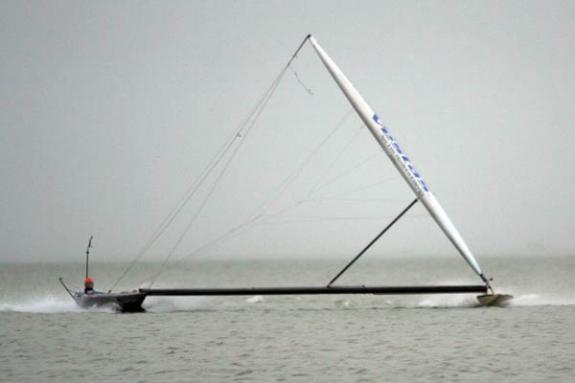
A visibly smaller 'jet' of spray to windward due to the muffling effect of the spray deflector. This is a 'brightened' up shot... the following is the actual shot showing the true 'greyness'.

Pretty grey hey? Put a rotten egg under your nose for an extra touch of reality.
I held Vestas SailRocket on course until we passed the last SEAFLEX buoy marking the end of the course and then checked out how well the skeg steering would function during a slow down sequence. It maintained control for all of the necessary manoeuvres. The large low speed rudder came back down nicely and all was back to normal.
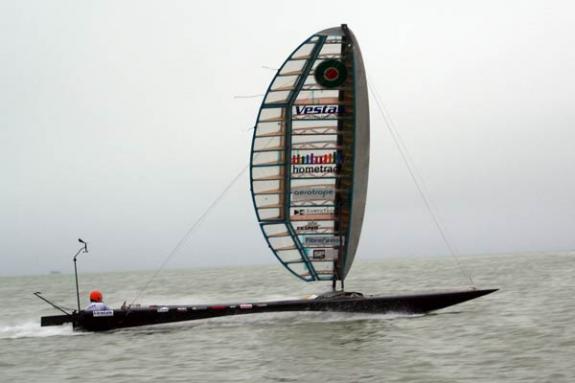
Here the rudder is kicked up, we are doing about 32 knots and look how much less spray there is off the back of the boat with it up. She felt light and slippery.
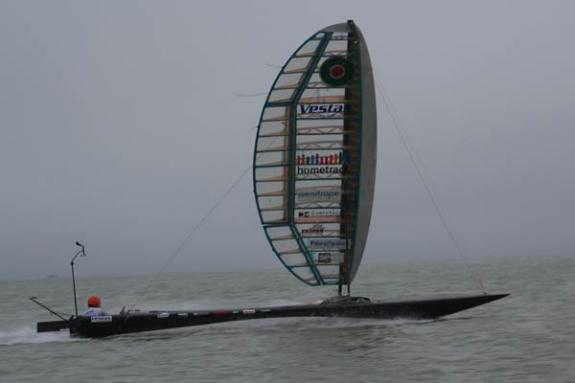
And the grey version again...
So overall it was a very clean run where a number of necessary improvements were trialled. We went through a full sequence of what needs to be done for a record run and everything worked well. Now I am more aware than anyone of how easy it can all look in lightish conditions and how pear shaped it can go in a blow... but, from my perspective in the cockpit... this was a good day that lays a foundation for runs to follow.
The MUSTO gear had us smiling throughout a rather cold old day. In fact the contrast in the modified and the real pictures above could also represent the change in our comfort level.
Happy days.
Today also looks good with even more wind... so let's see if the ease of run 40 will translate.
Cheers, Paul
PRESS RELEASE FROM VESTAS WIND SYSTEMS A/S
Vestas Technology R&D sponsors contender for world’s fastest sailing boat
Maximal use of wind power and cutting edge technology are the main reasons behind Vestas Technology R&D’s sponsorship of SailRocket.
The Vestas SailRocket Team behind this project will this year try to be the fastest sailing boat in the world being the first to go 50 knots (91.7 km/h). The unique design of the Vestas SailRocket gives maximal impact from the wind. The vessel uses around 2.2 times wind speed, so in order to go 50 knots it requires 23 knots of wind.